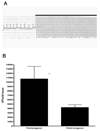Genome-wide association identifies a deletion in the 3' untranslated region of striatin in a canine model of arrhythmogenic right ventricular cardiomyopathy
- PMID: 20596727
- PMCID: PMC2962869
- DOI: 10.1007/s00439-010-0855-y
Genome-wide association identifies a deletion in the 3' untranslated region of striatin in a canine model of arrhythmogenic right ventricular cardiomyopathy
Abstract
Arrhythmogenic right ventricular cardiomyopathy (ARVC) is a familial cardiac disease characterized by ventricular arrhythmias and sudden cardiac death. It is most frequently inherited as an autosomal dominant trait with incomplete and age-related penetrance and variable clinical expression. The human disease is most commonly associated with a causative mutation in one of several genes encoding desmosomal proteins. We have previously described a spontaneous canine model of ARVC in the boxer dog. We phenotyped adult boxer dogs for ARVC by performing physical examination, echocardiogram and ambulatory electrocardiogram. Genome-wide association using the canine 50k SNP array identified several regions of association, of which the strongest resided on chromosome 17. Fine mapping and direct DNA sequencing identified an 8-bp deletion in the 3' untranslated region (UTR) of the Striatin gene on chromosome 17 in association with ARVC in the boxer dog. Evaluation of the secondary structure of the 3' UTR demonstrated that the deletion affects a stem loop structure of the mRNA and expression analysis identified a reduction in Striatin mRNA. Dogs that were homozygous for the deletion had a more severe form of disease based on a significantly higher number of ventricular premature complexes. Immunofluorescence studies localized Striatin to the intercalated disc region of the cardiac myocyte and co-localized it to three desmosomal proteins, Plakophilin-2, Plakoglobin and Desmoplakin, all involved in the pathogenesis of ARVC in human beings. We suggest that Striatin may serve as a novel candidate gene for human ARVC.
Figures









Similar articles
-
Association of dilated cardiomyopathy with the striatin mutation genotype in boxer dogs.J Vet Intern Med. 2013 Nov-Dec;27(6):1437-40. doi: 10.1111/jvim.12163. Epub 2013 Aug 28. J Vet Intern Med. 2013. PMID: 24033487
-
The role of vector-borne pathogens and cardiac Striatin genotype on survival in boxer dogs with arrhythmogenic right ventricular cardiomyopathy.J Vet Cardiol. 2024 Dec;56:84-96. doi: 10.1016/j.jvc.2024.09.002. Epub 2024 Sep 19. J Vet Cardiol. 2024. PMID: 39418695
-
Natural history of arrhythmogenic right ventricular cardiomyopathy in the boxer dog: a prospective study.J Vet Intern Med. 2014 Jul-Aug;28(4):1214-1220. doi: 10.1111/jvim.12385. Epub 2014 Jun 24. J Vet Intern Med. 2014. PMID: 24962663 Free PMC article.
-
Arrhythmogenic right ventricular cardiomyopathy/dysplasia: a review and update.Clin Res Cardiol. 2011 May;100(5):383-94. doi: 10.1007/s00392-011-0295-2. Epub 2011 Mar 1. Clin Res Cardiol. 2011. PMID: 21360243 Review.
-
Arrhythmogenic Right Ventricular Cardiomyopathy in the Boxer Dog: An Update.Vet Clin North Am Small Anim Pract. 2017 Sep;47(5):1103-1111. doi: 10.1016/j.cvsm.2017.04.007. Epub 2017 Jun 21. Vet Clin North Am Small Anim Pract. 2017. PMID: 28647112 Review.
Cited by
-
Genotype imputation in the domestic dog.Mamm Genome. 2016 Oct;27(9-10):485-94. doi: 10.1007/s00335-016-9636-9. Epub 2016 Apr 29. Mamm Genome. 2016. PMID: 27129452 Free PMC article.
-
The genetic basis of hypertrophic cardiomyopathy in cats and humans.J Vet Cardiol. 2015 Dec;17 Suppl 1(Suppl 1):S53-73. doi: 10.1016/j.jvc.2015.03.001. J Vet Cardiol. 2015. PMID: 26776594 Free PMC article. Review.
-
Common variants in 22 loci are associated with QRS duration and cardiac ventricular conduction.Nat Genet. 2010 Dec;42(12):1068-76. doi: 10.1038/ng.716. Epub 2010 Nov 14. Nat Genet. 2010. PMID: 21076409 Free PMC article.
-
Mutations with pathogenic potential in proteins located in or at the composite junctions of the intercalated disk connecting mammalian cardiomyocytes: a reference thesaurus for arrhythmogenic cardiomyopathies and for Naxos and Carvajal diseases.Cell Tissue Res. 2012 May;348(2):325-33. doi: 10.1007/s00441-012-1365-0. Epub 2012 Mar 27. Cell Tissue Res. 2012. PMID: 22450909 Free PMC article. Review.
-
"Ryanopathies" and RyR2 dysfunctions: can we further decipher them using in vitro human disease models?Cell Death Dis. 2021 Nov 1;12(11):1041. doi: 10.1038/s41419-021-04337-9. Cell Death Dis. 2021. PMID: 34725342 Free PMC article. Review.
References
-
- Barrett JC, Fry B, Mallet J, Daly MJ. Haploview analysis and visualization of LD and haploview maps. Bioinformatics. 2004;21:263–265. - PubMed
-
- Bartoli M, Ternaud JP, Forni C, Portalier P, Salin P, Amalric M, Monneron A. Down regulation of Striatin, a neuronal rat locomoter activity. J Neurobiol. 1999;40:234–243. - PubMed
-
- Basso CB, Corrado D, Nava A. Arrhythmogenic right ventricular cardiomyopathy. Lancet. 2009;373:1289–1300. - PubMed
-
- Basso CB, Fox PR, Meurs KM, Towbin JA, Spier AW, Calabrese F, Maron BJ, Thiene G. Arrhythmogenic right ventricular cardiomyopathy causing sudden cardiac death in boxer dogs: New animal model of human disease. Circulation. 2004;109:1180–1185. - PubMed
MeSH terms
Substances
Grants and funding
LinkOut - more resources
Full Text Sources
Other Literature Sources

